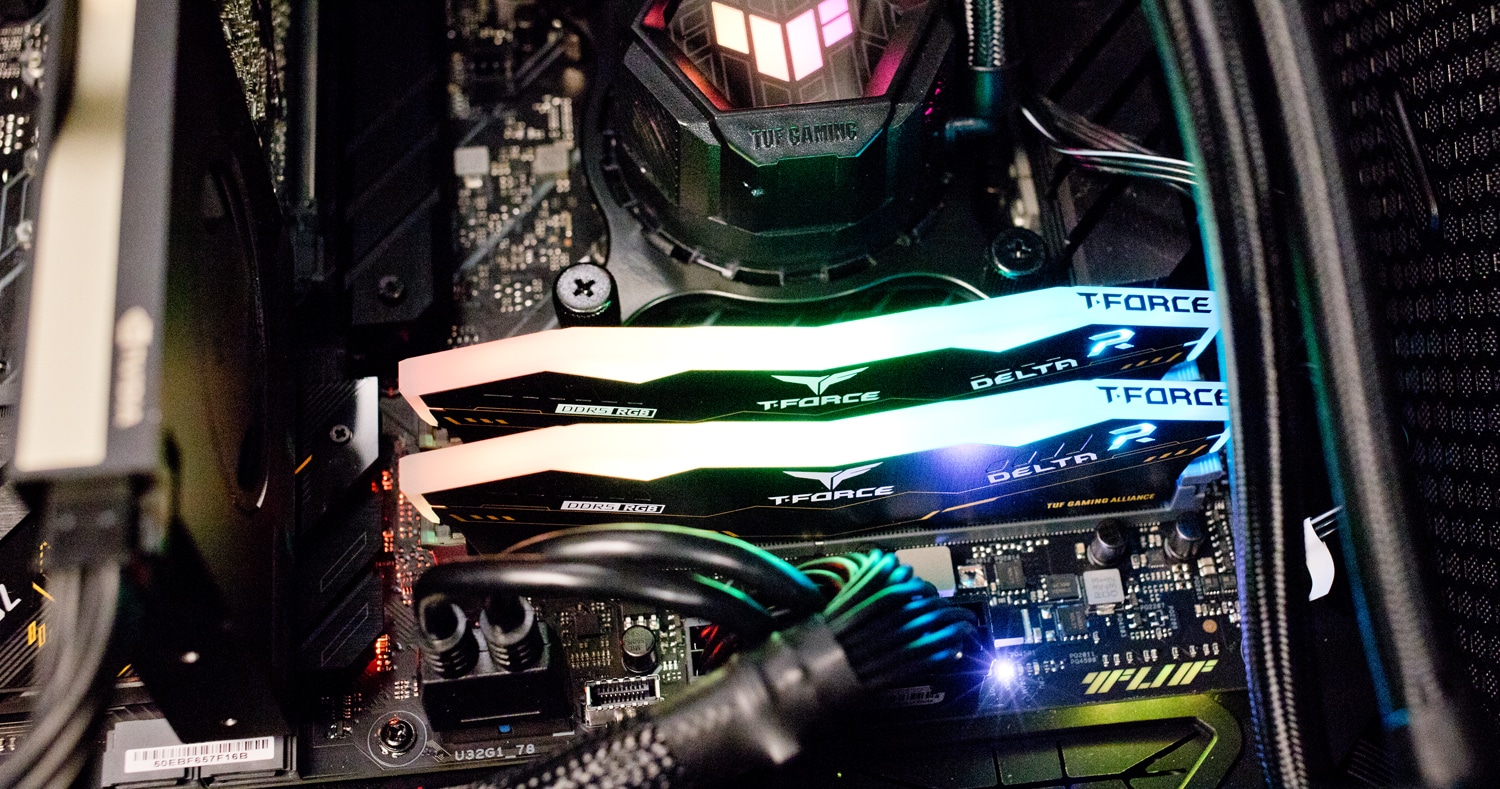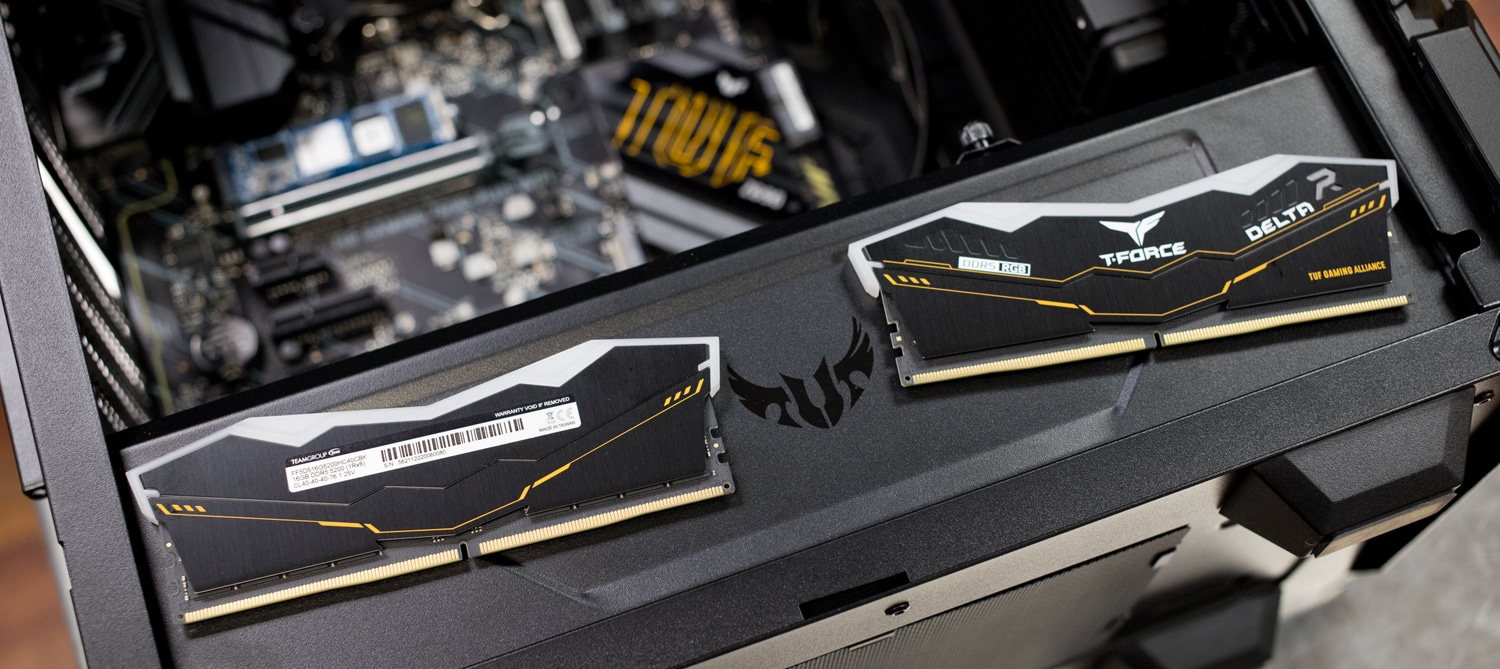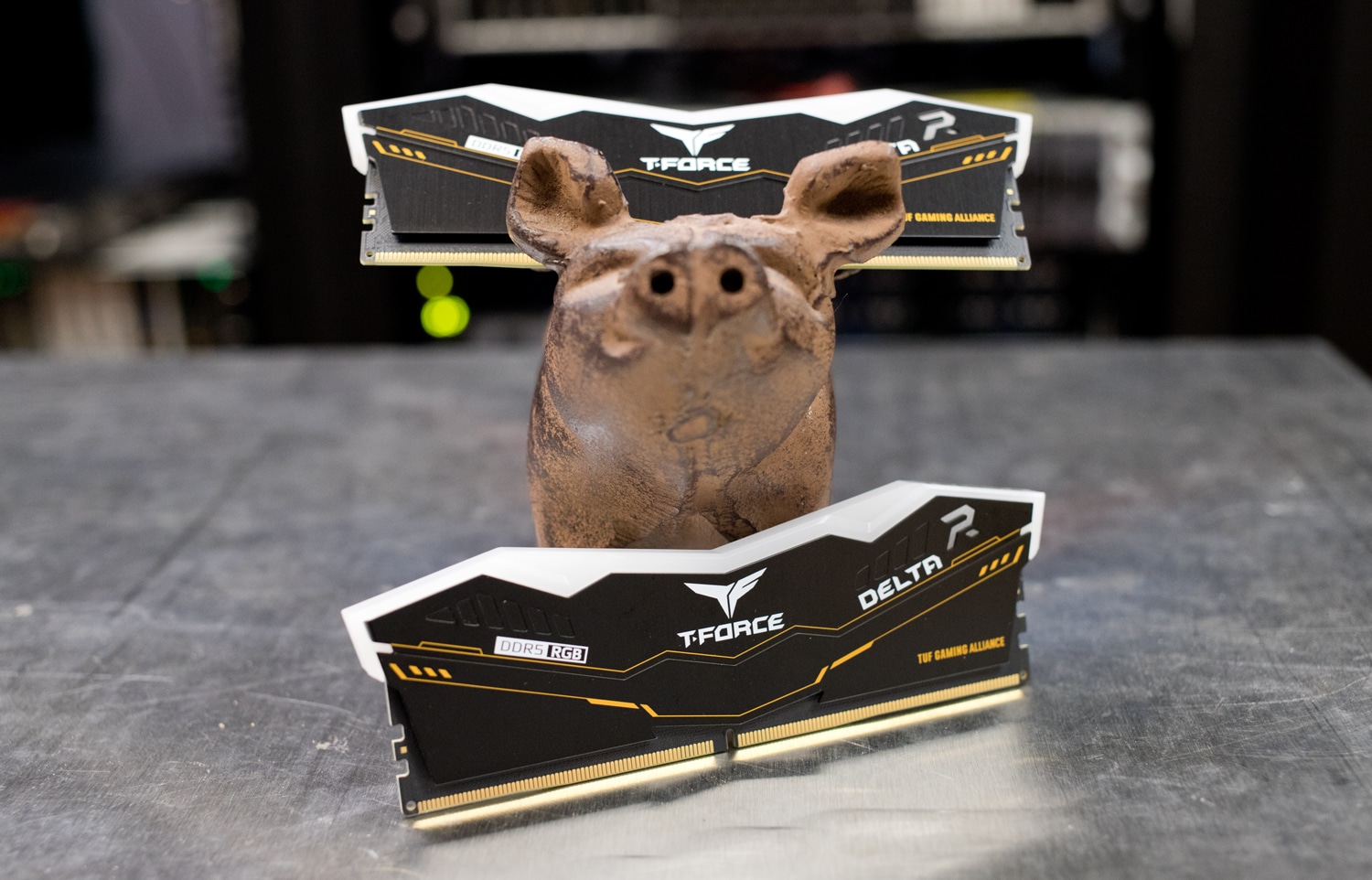Next up in our DDR5 memory review series is Team Group’s T-Force Delta TUF RGB DDR5 kit. This high-performance memory operates at higher frequencies than the DDR5 standard, 5200MHz versus 4800MHz, includes RGB-lit heat spreaders, and a lifetime warranty.
Next up in our DDR5 memory review series is Team Group’s T-Force Delta TUF RGB DDR5 kit. This high-performance memory operates at higher frequencies than the DDR5 standard, 5200MHz versus 4800MHz, includes RGB-lit heat spreaders, and a lifetime warranty.

Team Group T-Force Delta TUF RGB DDR5-5200 Specifications
Late 2021 saw the introduction of the new DDR5 memory standard, the replacement for the venerable DDR4 standard that has been around since 2014. DDR5 promises higher bandwidth and lower power consumption, though it’s expensive since it’s not being produced in huge quantities just yet. Expect to spend about twice as much as DDR4 for the same capacity.
Team Group is known for solid value offerings but also ventures into the high-end space, where the 32GB (2x 16GB) kit of T-Force Delta TUF RGB DDR5-5200 we’re reviewing is positioned. It’s currently $319 on Amazon, or considerably more than the Kingston Fury Beast ($242) and XPG Lancer RGB ($279) DDR5-5200 kits we already reviewed.

The DIMMs themselves look particularly aggressive. The black heatspreaders have a jagged RGB-infused edge on top. You can control the lighting effects through the RGB software included with your motherboard. If you have a low-hanging CPU cooler, make sure it will clear these 46.1mm tall DIMMs.
Installing DDR5 is no different than installing DDR4, DDR3, or even earlier DDR. DDR5 DIMMs are 288-pin just like DDR4 but won’t fit in the same slots because the notch position is different.
The full specifications of this Team Group memory are as follows. (See this memory on Team Group’s site.)
| Module Type | DDR5 288 Pin non-ECC Unbuffered DIMM |
| Frequency | 5200MHz |
| Latency | CL40-40-40-76 |
| Capacity | 16GB x2 |
| Data Transfer Bandwidth | 41,600MB/s (PC5-41600) |
| Voltage | 1.25V |
| Compatibility | Intel: Z690/B660 |
| Dimensions | 46.1 (H) x 144.2 (L) x 7 (W) mm |
| Warranty | Lifetime warranty |
Team Group T-Force Delta TUF RGB DDR5-5200 Performance
We use our self-built StorageReview desktop to test DDR5 memory. It has the following specifications:
- Intel Core i9-12900K CPU (slightly undervolted)
- Asus ROG Strix Z690-E Gaming WiFi motherboard
- Microsoft Windows 11
- Seagate FireCuda 530 2TB SSD
The T-Force Delta TUF RGB DDR5-5200 memory kit as reviewed here is two 16GB modules (32GB total). Our benchmarks were done at its rated DDR5-5200 speed both with and without its XMP II profile engaged. The XMP II profile settings happened to be the same at our motherboard’s default settings; its timings in either event are DDR5-5200 CL40-40-40-61.
The other kits we are using for comparison include:
- 32GB (2x 16GB) Kingston Fury Beast DDR5-5200
- DDR5-4800 CL40-39-39-58 (no XMP)
- DDR5-4800 CL38-38-38-57 (XMP II)
- DDR5-5200 CL40-39-39-61 (no XMP)
- DDR5-5200 CL40-40-40-61 (XMP II)
- 64GB (2x 32GB) Corsair Vengeance DDR5-4400
- DDR5-4000 CL32-32-32-54 (no XMP; would not run at rated DDR5-4400 without XMP)
- DDR5-4400 CL36-36-36-59 (XMP II)
- 32GB (2x 16GB) XPG Lancer RGB DDR5-5200
- DDR5-5200 CL40-40-40-61 (no XMP)
- DDR5-5200 CL38-38-38-60 (XMP II)
These kits aren’t all the same size or capacity, so some of the comparisons will be inexact. Nonetheless, we’ll see be able to see if the Team Group memory shows advantages over the other DDR5-5200 kits, and if DDR5-5200 makes a difference over the slower Corsair DDR5-4400 kit.
Already we can see that the Team Group memory doesn’t have as low of timings as the others in XMP II, though it remains to be seen if that’s going to adversely affect its performance.
SiSoftware Sandra 2021
Our first test is the popular SiSoftware Sandra 2021. Higher numbers are better in all subtests. The DDR5-5200 tests are first, both with and without XMP II profiles engaged. The Corsair kit will sit this out since it can’t operate above DDR5-4400.
| Team Group T-Force Delta TUF RGB DDR5-5200 | Kingston Fury Beast DDR5-5200 | XPG Lancer RGB DDR5-5200 | ||||
| No XMP | XMP II | No XMP | XMP II | No XMP | XMP II | |
| Memory Bandwidth | 62.352GB/s | 62.243GB/s | 62.758GB/s | 61.811GB/s | 62.560GB/s | 62.945GB/s |
| Cache & Memory Latency | 32.9ns | 33.4ns | 32.9ns | 33.4ns | 32.9ns | 34.0ns |
| Cache & Memory Bandwidth | 487.508GB/s | 487.176GB/s | 493.096GB/s | 484.779GB/s | 485.656GB/s | 487.290GB/s |
| Overall Memory Score | 2.44kPT | 2.46kPT | 2.48kPT | 2.44kPT | 2.46kPT | 2.44kPT |
All the kits were close, and if anything, the Team Group kit trailed slightly in bandwidth, peaking at 62.352GB/s versus the XPG’s 62.945GB/s, both with XMP II engaged. Interestingly, the Team Group’s latency was slightly lower without XMP II engaged (32.9ns versus 33.4ns), though this could have been just a testing discrepancy.
To see how DDR5-5200 fares against DDR5-4400 and DDR5-4000, we now face off the Team Group, Kingston, and Corsair kits. We downclocked the Kingston kit to DDR5-4800, and the Corsair kit runs at DDR5-4000 (our board’s default settings) or DDR5-4400 (XMP II).
| Team Group T-Force Delta TUF RGB DDR5-5200 | Kingston Fury Beast DDR5-4800 | Corsair Vengeance DDR5 | ||||
| No XMP | XMP II | No XMP | XMP II | No XMP (DDR5-4000) | XMP II (DDR5-4400) | |
| Memory Bandwidth | 62.352GB/s | 62.243GB/s | 54.418GB/s | 58.801GB/s | 52.654GB/s | 54.403GB/s |
| Cache & Memory Latency | 32.9ns | 33.4ns | 34.6ns | 34.5ns | 35.9ns | 35.3ns |
| Cache & Memory Bandwidth | 487.508GB/s | 487.176GB/s | 479.352GB/s | 479.322GB/s | 465.443GB/s | 471.794GB/s |
| Overall Memory Score | 2.44kPT | 2.46kPT | 2.35kPT | 2.36kPT | 2.23kPT | 2.27kPT |
The differences are now pronounced; the Team Group kit shows significant bandwidth advantages over the slower frequency kits to the tune of nearly 15% against the Corsair at DDR5-4400. Its extra frequency also more than makes up for its slower timings.
7-Zip Compression Benchmark
The excellent 7-Zip file archive tool has a handy built-in compression benchmark. We ran 10 passes using a 128MB dictionary size and all 24 CPU threads of our Core i9-12900K; higher numbers are better.
| Team Group T-Force Delta TUF RGB DDR5-5200 | Kingston Fury Beast DDR5-5200 | XPG Lancer RGB DDR5-5200 | ||||
| No XMP | XMP II | No XMP | XMP II | No XMP | XMP II | |
| Compressing | ||||||
| Current CPU Usage | 2021% | 2040% | 2022% | 2014% | 2020% | 2012% |
| Current Rating/Usage | 4.878 GIPS | 4.810 GIPS | 4.846 GIPS | 4.898 GIPS | 4.914 GIPS | 4.952 GIPS |
| Current Rating | 98.558 GIPS | 98.109 GIPS | 97.977 GIPS | 98.664 GIPS | 99.263 GIPS | 99.645 GIPS |
| Resulting CPU Usage | 2025% | 2023% | 2024% | 2017% | 2021% | 2022% |
| Resulting Rating/Usage | 4.858 GIPS | 4.850 GIPS | 4.847 GIPS | 4.855 GIPS | 4.875 GIPS | 4.908 GIPS |
| Resulting Rating | 98.369 GIPS | 98.142 GIPS | 98.098 GIPS | 97.934 GIPS | 98.499 GIPS | 99.257 GIPS |
| Decompressing | ||||||
| Current CPU Usage | 2314% | 2325% | 2264% | 2306% | 2300% | 2298% |
| Current Rating/Usage | 5.839 GIPS | 5.703 GIPS | 5.764 GIPS | 5.661 GIPS | 5.856 GIPS | 5.822 GIPS |
| Current Rating | 135.102 GIPS | 132.588 GIPS | 130.510 GIPS | 130.539 GIPS | 134.663 GIPS | 133.801 GIPS |
| Resulting CPU Usage | 2304% | 2300% | 2276% | 2298% | 2300% | 2292% |
| Resulting Rating/Usage | 5.806 GIPS | 5.776 GIPS | 5.781 GIPS | 5.737 GIPS | 5.811 GIPS | 5.774 GIPS |
| Resulting Rating | 133.791 GIPS | 132.838 GIPS | 131.604 GIPS | 131.818 GIPS | 133.669 GIPS | 132.347 GIPS |
| Total Ratings | ||||||
| Total CPU Usage | 2165% | 2162% | 2150% | 2157% | 2160% | 2157% |
| Total Rating/Usage | 5.332 GIPS | 5.313 GIPS | 5.314 GIPS | 5.296 GIPS | 5.343 GIPS | 5.341 GIPS |
| Total Rating | 116.080 GIPS | 115.490 GIPS | 114.851 GIPS | 114.876 GIPS | 116.084 GIPS | 115.082 GIPS |
The differences seem insignificant based on the total ratings, so we focus on the compression sub-scores. There, the Team Group kit topped out at a resulting rating of 98.369 GIPS, matching the Kingston kit (98.664 GIPS) but not quite matching the XPG kit (99.257 GIPS).
Now, as before, we’ll see how the Team Group kit stacks against the Kingston kit at DDR5-4800 and the Corsair kit at DDR5-4400 and DDR5-4000.
| Team Group T-Force Delta TUF RGB DDR5-5200 | Corsair Vengeance DDR5 | Kingston Fury Beast DDR5-4800 | ||||
| No XMP | XMP II | No XMP (DDR5-4000) | XMP II (DDR5-4400) | No XMP | XMP II | |
| Compressing | ||||||
| Current CPU Usage | 2021% | 2040% | 2001% | 1996% | 2035% | 2016% |
| Current Rating/Usage | 4.878 GIPS | 4.810 GIPS | 4.478 GIPS | 4.583 GIPS | 4.565 GIPS | 4.595 GIPS |
| Current Rating | 98.558 GIPS | 98.109 GIPS | 89.612 GIPS | 91.460 GIPS | 92.913 GIPS | 92.664 GIPS |
| Resulting CPU Usage | 2025% | 2023% | 1999% | 2004% | 2032% | 2017% |
| Resulting Rating/Usage | 4.858 GIPS | 4.850 GIPS | 4.401 GIPS | 4.537 GIPS | 4.601 GIPS | 4.656 GIPS |
| Resulting Rating | 98.369 GIPS | 98.142 GIPS | 87.978 GIPS | 90.932 GIPS | 93.468 GIPS | 93.905 GIPS |
| Decompressing | ||||||
| Current CPU Usage | 2314% | 2325% | 2307% | 2296% | 2278% | 2319% |
| Current Rating/Usage | 5.839 GIPS | 5.703 GIPS | 5.681 GIPS | 5.702 GIPS | 5.766 GIPS | 5.700 GIPS |
| Current Rating | 135.102 GIPS | 132.588 GIPS | 131.065 GIPS | 130.922 GIPS | 131.324 GIPS | 132.166 GIPS |
| Resulting CPU Usage | 2304% | 2300% | 2284% | 2291% | 2247% | 2312% |
| Resulting Rating/Usage | 5.806 GIPS | 5.776 GIPS | 5.701 GIPS | 5.722 GIPS | 5.744 GIPS | 5.721 GIPS |
| Resulting Rating | 133.791 GIPS | 132.838 GIPS | 130.237 GIPS | 131.083 GIPS | 129.050 GIPS | 132.262 GIPS |
| Total Ratings | ||||||
| Total CPU Usage | 2165% | 2162% | 2142% | 2147% | 2139% | 2164% |
| Total Rating/Usage | 5.332 GIPS | 5.313 GIPS | 5.051 GIPS | 5.130 GIPS | 5.172 GIPS | 5.188 GIPS |
| Total Rating | 116.080 GIPS | 115.490 GIPS | 109.108 GIPS | 111.008 GIPS | 111.259 GIPS | 113.083 GIPS |
Expectedly, the Team Group’s higher frequency shows it performing much better across the board. In the compression scores, its 98.369 GIPS rating outshined the Corsair kit (91.460 GIPS at DDR5-4400) and the Kingston kit (92.664 GIPS at DDR5-4800 in XMP II).
Conclusion
Team Group T-Force Delta TUF RGB DDR5 performed about as well as Kingston Fury Beast, though it wasn’t the fastest DDR5-5200 kit we’ve tested; that honor goes to XPG Lancer RGB. The performance differences between those kits are minimal in the grand picture and we don’t advocate spending significantly more for one kit versus another for that reason.
That said, there are lots to like about Team Group’s entry – its flashy RGB-lit heat spreaders, XMP II profiles for easy overclocking (as DDR5-5200 is an overclock versus DDR5-4800), and lifetime warranty. Its price is too high next to XPG Lancer RGB, and Kingston Fury Beast is even less expensive if you’re willing to forego RGB lighting. But DDR5 pricing is fluid, when Team Group’s price drops to slightly below XPG’s levels, it’ll be an excellent alternative.
Engage with StorageReview
Newsletter | YouTube | Podcast iTunes/Spotify | Instagram | Twitter | Facebook | TikTok | RSS Feed

